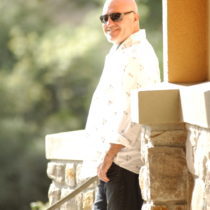Landscape Architecture for Landscape Architects › Forums › DETAILS & MATERIALS › Artificial rock as a design medium (#6 of 10)
- This topic has 0 replies, 1 voice, and was last updated 15 years, 4 months ago by
 Matthew E Wilson.
Matthew E Wilson.
-
AuthorPosts
-
December 8, 2008 at 5:47 pm #175859
 Matthew E WilsonParticipant
Matthew E WilsonParticipantDesign theory (article #6 of 10)
Design is probably the most subjective area of debate for beauty is in the eyes of the beholder or your client for that matter. Rock is a powerful medium to all creatures here on earth and if you doubt that statement take a trip to the Yosemite Valley, the Grand Canyon or look at any photograph of the Seychelles islands. What makes the single most memorable statement at those locations? Rock. Rock gives a presence and a stabilizing focal point and creates a distinct feeling to any exhibit space regardless of theme. Many people state that rock does not fit into modern or contemporary themed environments and I would challenge that limited thinking. Many designers are relating to rock as an insignificant imported item littered throughout an environment space which is true with real rock. I would like to encourage designers to view rock from a different paradigm, one of a preexisting natural formation, if designed and fabricated well, to the project site. Look at the rock outcropping as a natural exiting feature before the building was erected and you will have a fresh perspective on what I am suggesting. Any theme can be improved by the addition of very large rock sculptures regardless of the size of the exhibit space if adequate plant material is incorporated into the design process.
From my perspective many credible designers lack, of all things, imagination because they get stuck with the same design parameters that they have had success with in the past. Getting a designer to actually be original each and every time after a track record of success is near impossible. If one does not challenge themselves to rethink and reinvent at least periodically, you risk the perils of complacency. If you are not routinely challenged to think a completely original thought regardless, of budget, deadline, location, what happens? Boredom, drudgery and burn out. Truly gifted, creative people must create something original constantly because we get bored too easily with the same old thing.
After literally years of trial by fire I have figured out what most clients enjoy and respond to in terms of rockwork design. Coincidently they are the exact same requirements for captive animal habitats. They are as follows; shadowing, fissures, water movement, telling a geologic story, color, balance, intrigue, and softening.
Each of these items relates to the other and the overall complexity of each project, and all are required to some degree to achieve the most believable and natural looking results. The number one response comes from shadowing. The ability to create three-dimensional shapes that cast shadow to their surrounding parts. This is actually harder to achieve than it sounds given engineering requirements and gravity fighting you every step of the way. These could be fissures or joints from one rock to another or under and over hangs. Fissures are deep cracks from 3” inches to three feet in depth that separate two fracture planes thus creating a deep dark shadow into the joint.
This same action an be achieved by utilizing gfrc rock castings in a narrow rectilinear shapes much akin to stair steps turned upside down. It can also be achieved vertically by placing two gfrc rock castings connected in the back next to each other to dimensionalize two separate rocks.
Next article
More design theory
Quote
“There is light at the end of the tunnel. . .just pray its not a train”
-
AuthorPosts
- You must be logged in to reply to this topic.

